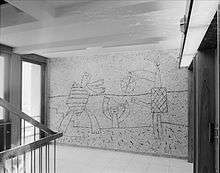Picasso's Regjeringskvartalet murals


In the late 1950s and the early 1970s the Spanish artist Pablo Picasso designed five murals (The Beach, The Seagull, Satyr and Faun and two versions of The Fisherman) for the Regjeringskvartalet ('Government quarter') buildings in central Oslo, Norway.[1] The designs by Picasso were executed in concrete by Norwegian artist Carl Nesjar, and were Picasso's first attempt at monumental concrete murals.[1][2] The buildings onto which the murals were executed are known as the 'H-block' or Highrise (1959) and 'Y-block' (1968); they were designed by the Norwegian architect Erling Viksjø.[3] The largest mural, The Fisherman (1970) is on the façade of Y-block. Picasso would later create works in a similar vein in Barcelona and Stockholm.[2]
2011 Norway attacks
The Regjeringskvartalet complex was badly damaged by a car bomb that exploded on 22 July 2011.[1] The Norwegian government is considering demolishing the buildings, after they were damaged during the bombing, and dismantling and reconstructing the murals.[1] The Regjeringskvartalet government complex was built in the modernist style, and has been likened to the architecture of Communist Eastern Europe.[1]
In a poll, 40 percent of respondents were in favour of demolishing the damaged buildings.[1] The director of the Norwegian Directorate for Cultural Heritage, Jørn Holme, has defended the buildings, saying that "We can't demolish the best parts of a cultural era just because we find it ugly today." He stressed that if they were moved they would "no longer be the works Picasso intended". It is the position of the Directorate that the murals be restored and kept in their original site, additionally they declared the buildings were safe to use despite their damage.[1][2] The Directorate described the complex as a "cornerstone in Norwegian architectural history".[2]
A decision on the fate of the murals was expected in early 2014.[1] The murals were subsequently listed as one of Europe's most endangered heritage sites in 2015 by the heritage organisation Europa Nostra following the Norwegian cabinet's vote to demolish the Y-block building.[4]
References
- 1 2 3 4 5 6 7 8 Tony Paterson (18 August 2013). "Norway's 'ugly' buildings – with a touch of Picasso's genius – under threat of demolition". The Independent.
- 1 2 3 4 Clemens Bomsdorf (14 January 2013). "Picasso murals under threat". The Art Newspaper.
- ↑ "Picasso – Oslo. Art and architecture in the Government quarter". Visit Oslo.
- ↑ Henri Neuendorf. "Picasso Mural in Norway Among Europe's Most Threatened Heritage Sites". ArtNet News. ArtNet. Retrieved 14 March 2016.